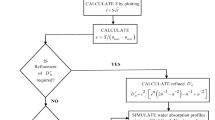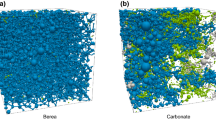Abstract
This article presents a dual method for the determination of thermophysical and hydric properties of porous materials. First empirical relationships between thermophysical properties and moisture content were determined. Then, a laboratory setup allowed for temperature recording during a drying test. Empirical relationships and recorded data are the algorithm inputs. The two stages algorithm is based on a finite difference discretization and a parametric estimation. Autoclaved Aerated Concrete was tested in this case study and positive estimation results with 8 % accuracy are encouraging outcome for next use of the method.




















Similar content being viewed by others
Abbreviations
- C :
-
Volumetric heat capacity (J K−1 m−3)
- D :
-
Moisture diffusivity (m2 s−1)
- F :
-
Objective function
- m :
-
Mass (kg)
- m dry :
-
Dry mass (kg)
- p :
-
Parameters array
- T :
-
Temperature (°C)
- t :
-
Time (s)
- x :
-
Space (thickness, m)
- α :
-
Thermal diffusivity (m2 s−1)
- λ :
-
Thermal conductivity (W K−1 m−1)
- ρ :
-
Density (kg m−3)
- ρ dry :
-
Dry density (kg m−3)
- ω :
-
Moisture content (MC) (%)
- ω sat :
-
Saturated moisture content (%)
- i :
-
Time index
- j :
-
Space index
References
Schwarz V (2009) Promoting energy efficiency in buildings: Lessons learned from internatIonal experience (trans: Energy Ea). United Nations Development Programme, New York
Sartori I, Hestnes AG (2007) Energy use in the life cycle of conventional and low-energy buildings: a review article. Energy Build 39(3):249–257. doi:10.1016/j.enbuild.2006.07.001
John G, Clements-Croome D, Jeronimidis G (2005) Sustainable building solutions: a review of lessons from the natural world. Build Environ 40(3):319–328. doi:10.1016/j.buildenv.2004.05.011
Sadineni SB, Madala S, Boehm RF (2011) Passive building energy savings: a review of building envelope components. Renew Sustain Energy Rev 15(8):3617–3631. doi:10.1016/j.rser.2011.07.014
Meukam P, Noumowe A (2005) Modeling of heat and mass transfer in lateritic building envelopes. Heat Mass Transf 42(2):158–167. doi:10.1007/s00231-005-0006-5
Dincer I, Ozalp A, Zamfirescu C (2016) Drying phenomena: theory and applications. Wiley, New York
Luikov AV (1966) Heat and mass transfer in capillary-porous bodies. Pergamon Press, Oxford
Philip JR, De Vries DA (1957) Moisture movement in porous materials under temperature gradients. Eos Trans Am Geophys Union 38(2):222–232. doi:10.1029/TR038i002p00222
Baehr HD, Stephan K (2011) Heat and mass transfer. Springer, Berlin
Siwińska A, Garbalińska H (2011) Thermal conductivity coefficient of cement-based mortars as air relative humidity function. Heat Mass Transf 47(9):1077–1087. doi:10.1007/s00231-011-0772-1
Rahim M, Douzane O, Le Tran AD, Langlet T (2016) Effect of moisture and temperature on thermal properties of three bio-based materials. Constr Build Mater 111:119–127. doi:10.1016/j.conbuildmat.2016.02.061
Dotto GL, Pinto LAA, Moreira MFP (2015) Determination of the effective thermal diffusivity in a porous bed containing rice grains: effects of moisture content and temperature. Heat Mass Transf 52(4):887–896. doi:10.1007/s00231-015-1604-5
Narayanan N, Ramamurthy K (2000) Structure and properties of aerated concrete: a review. Cem Concr Compos 22(5):321–329. doi:10.1016/S0958-9465(00)00016-0
Tada S, Nakano S (1983) Microstructural approach to properties of moist cellular concrete. In: Proceedings autoclaved aerated concrete, moisture and properties. Elsevier, Amsterdam, pp 71–89
Korecký T, Ďurana K, Lapková M, Černý R (2012) Moisture diffusivity of AAC with different densities. International Journal of Civil, Environmental, Structural, Construction and Architectural Engineering 67:502–506
Delgado JMPQ, Freitas VP, Guimarães AS (2016) Water movement in building walls: interfaces influence on the moisture flux. Heat and Mass Transfer. doi:10.1007/s00231-016-1755-z
Fasina O, Sokhansanj S (1996) Estimation of moisture diffusivity coefficient and thermal properties of Alfalfa Pellets. J Agric Eng Res 63(4):333–343. doi:10.1006/jaer.1996.0036
Lu S, Ren T, Gong Y, Horton R (2007) An improved model for predicting soil thermal conductivity from water content at room temperature. Soil Sci Soc Am J. doi:10.2136/sssaj2006.0041
Derbal R, Defer D, Chauchois A, Brachelet F (2015) Estimation of the moisture content based on a thermal analysis method case of the sand. In: Paper presented at the third international conference on advances in applied science and environmental technology—ASET 2015, Bangkok, Thailand, 28–29 December, 2015
Derbal R, Defer D, Chauchois A, Antczak E (2014) A simple method for building materials thermophysical properties estimation. Constr Build Mater 63:197–205. doi:10.1016/j.conbuildmat.2014.04.076
Levenberg K (1944) A method for the solution of certain non-linear problems in least squares. Q Appl Math 2:164–168
Marquardt DW (1953) An algorithm for least-squares estimation of nonlinear parameters. J Soc Ind Appl Math 11:431–441
Özişik N, Orlande HRB (2000) Inverse heat transfer: fundamentals and applications. Taylor & Francis, London
Jiji LM (2009) Heat conduction, 3rd edn. Springer, Berlin
Pérez J-P (1993) Thermodynamique fondements et applications, 1st edn. MASSON, Paris
Crank J (1975) The mathematics of diffusion. Oxford science publications, vol Accessed from http://nla.gov.au/nla.cat-vn2708850. Clarendon Press, Oxford (England)
Özişik MN (1994) Finite difference methods in heat transfer. CRC Press, Boca Raton
Derbal R (2014) Développement d’une méthode inverse de caractérisation thermique: application à l’estimation des propriétés thermophysiques et hydriques des matériaux de construction. Université d’Artois, Béthune
Mathworks (2012) Nonlinear least squares (Curve Fitting). MathWorks. http://www.mathworks.fr/fr/help/optim/ug/lsqnonlin.html. Accessed Feb 2013
Rao SS (2009) Engineering optimization: theory and practice. Wiley, New York
Kulkarni NG, Bhandarkar UV, Puranik BP, Rao AB (2016) Experimental determination of thermal properties of alluvial soil. Heat and Mass Transf. doi:10.1007/s00231-016-1772-y
Nusier O, Abu-Hamdeh N (2003) Laboratory techniques to evaluate thermal conductivity for some soils. Heat and Mass Transf 39(2):119–123. doi:10.1007/s00231-002-0295-x
ASTM (1991) Standard test method for steady-state thermal transmission properties by means of the heat flow meter apparatus, vol C518. ASTM Standard C518, WASHINGTON, D.C
Tada S (2005) Simultaneous determination of sorption isotherm and water diffusivity of autoclaved aerated concrete. Conference on autoclaved aerated concrete - innovation and development, vol 1. Texte, Inc., Tokyo, Japan
De Vries DA (1958) Simultaneous transfer of heat and moisture in porous media. Eos Trans Am Geophys Union 39(5):909–916. doi:10.1029/TR039i005p00909
Author information
Authors and Affiliations
Corresponding author
Rights and permissions
About this article
Cite this article
Derbal, R., Defer, D. Thermophysical and hydric properties estimation based on a double inverse analysis. Heat Mass Transfer 53, 1375–1389 (2017). https://doi.org/10.1007/s00231-016-1907-1
Received:
Accepted:
Published:
Issue Date:
DOI: https://doi.org/10.1007/s00231-016-1907-1




